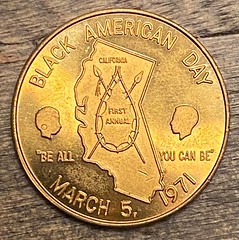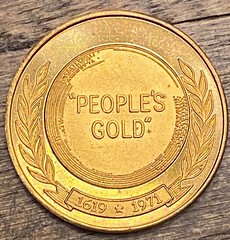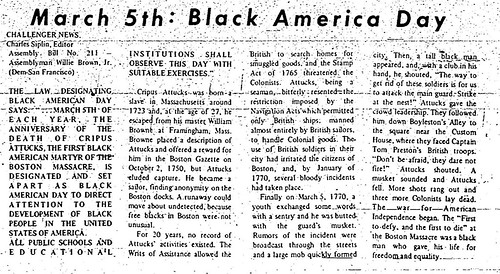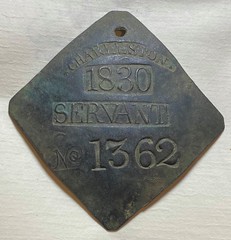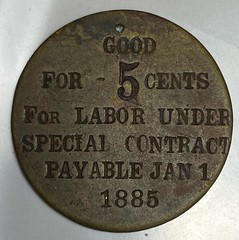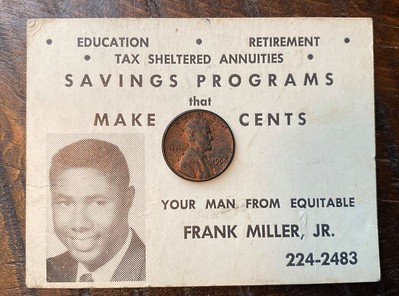
PREV ARTICLE
NEXT ARTICLE
FULL ISSUE
PREV FULL ISSUE
1971 BLACK AMERICAN DAY MEDALJohn Kraljevich posted the first of a planned series of Black History Month articles on Facebook this week. The first one highlights the 1971 Black American Day medal. I hadn't seen one of these before - thanks! -Editor In 1971, California held its "first annual Black American Day" on March 5, 1971. This brass medal was struck to mark the occasion. The obverse shows the map of California superimposed with a stylized shield of Kenya's Maasai people and the legend "Be All You Can Be." On the reverse, the words "People's Gold" is placed within a wreath with the dates 1619 and 1971. Yes, the date 1619, when the first Africans arrived in Virginia, has always held special meaning. The California Black American Day holiday was conceived by Assemblyman Willie Brown, later mayor of San Francisco, in 1969, the year he was first elected to the California Assembly. He initially wanted the holiday to be celebrated on January 14, to mark Dr. Martin Luther King, Jr.'s birthday, but that idea failed to gain support. (King's birthday became a Federal holiday in 1983.) More than a year later, Brown's bill passed, with his Black American Day slated for March 5, the day Crispus Attucks, an African-American, was killed at the 1770 Boston Massacre. It was signed into law by Governor Ronald Reagan, who also signed the Martin Luther King, Jr. Day observance into Federal law as President, an ironic twist to the legacy of the man who gave a 1980 campaign speech on "states rights" at the Neshoba County Fair in Philadelphia, Mississippi, which was then famous for just one thing: a 1964 triple murder of civil rights activists. While Brown's successful passage of Black American Day legislation was a victory for the recognition of African-American history and culture in California and nationwide, one group did not celebrate it: the Black Panthers. The Panthers had already conceived March 5, 1971 as their "Revolutionary Intercommunal Day of Solidarity" to bring attention to the BPP's political prisoners, including Chairman Bobby Seale and Angela Davis. They gathered at the Oakland Coliseum that night for an event to raise interest in the plights of the imprisoned Panthers. The musical act was the Grateful Dead. This medal issued to mark Black American Day is scarce, but not worth very much. I paid less than $20 for it. All this month, I'll be showcasing other items from my collection of African-American related coins, medals, tokens, paper money, and related items, many of which are as interesting as this even though their value isn't much more. Feel free to share, ask questions, and look for further installments every day this month. I reordered this to put the numismatic part first, but John's introduction is important, so here it is in its entirety. -Editor
Black History Month, 2021. Day 1.
Black History Month traces its lineage back to Negro History Week, a creation of historian Carter G. Woodson in 1926. Woodson is the namesake of the University of Virginia's Carter G. Woodson Institute for African-American and African Studies, the academic outlet that provided me my first introduction to the field. Woodson, whose parents were born enslaved, faced an uphill battle, as African-American history was not just entirely missing from contemporary texts, but Lost Cause ideologues sought to inject a counternarrative literally anywhere they could. Woodson chose the second week of February, the week both Abraham Lincoln and Frederick Douglass celebrated their birthdays. February became popularly recognized as Black History Month following the first celebration in 1970 at Kent State University.
To read the complete article, see:
Here are some additional posts in John's series. -Editor
To read the complete articles, see:
Wayne Homren, Editor The Numismatic Bibliomania Society is a non-profit organization promoting numismatic literature. See our web site at coinbooks.org. To submit items for publication in The E-Sylum, write to the Editor at this address: whomren@gmail.com To subscribe go to: https://my.binhost.com/lists/listinfo/esylum All Rights Reserved. NBS Home Page Contact the NBS webmaster 
|
